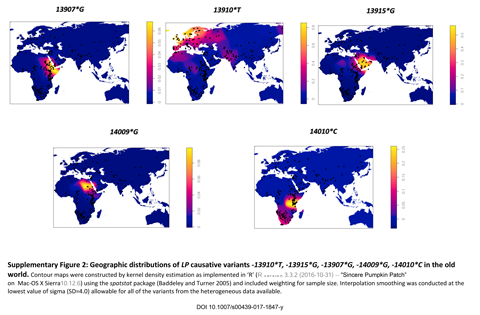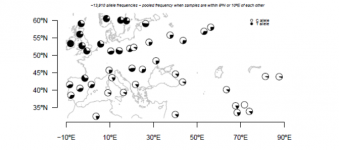Angela
Elite member
- Messages
- 21,823
- Reaction score
- 12,329
- Points
- 113
- Ethnic group
- Italian
See: Anke Liebert et al
https://link.springer.com/content/pdf/10.1007/s00439-017-1847-y.pdf
"The genetic trait of lactase persistence (LP) is associated with at least five independent functional single nucleotide variants in a regulatory region about 14 kb upstream of the lactase gene [−13910*T (rs4988235), −13907*G (rs41525747), −13915*G (rs41380347), −14009*G (rs869051967) and −14010*C (rs145946881)]. These alleles have been inferred to have spread recently and present-day frequencies have been attributed to positive selection for the ability of adult humans to digest lactose without risk of symptoms of lactose intolerance. One of the inferential approaches used to estimate the level of past selection has been to determine the extent of haplotype homozygosity (EHH) of the sequence surrounding the SNP of interest. We report here new data on the frequencies of the known LP alleles in the ‘Old World’ and their haplotype lineages. We examine and confrm EHH of each of the LP alleles in relation to their distinct lineages, but also show marked EHH for one of the older haplotypes that does not carry any of the fve LP alleles. The region of EHH of this (B) haplotype exactly coincides with a region of suppressed recombination that is detectable in families as well as in population data, and the results show how such suppression may have exaggerated haplotype-based measures of past selection.

The supplementary materials can be found here:
http://www.umm.edu/news-and-events/...gest-pharaoh-akhenaten-had-two-rare-disorders
Basically, other than new frequency distribution, they seem to be saying that while there was selection and it was recent, there might be something structural going on in that area of the chromosome that drives the passing on and retention of these alleles, and not selection alone.
That makes sense to me given that, as they point out, it's not such a huge selective advantage given that you can make cheese products which spoil less quickly and can usually be digested by most people without real problems.
Anyway, they reiterate what has been proposed previously by Mathiesen that it was present in extremely low numbers perhaps in WHG given the earliest discovery of it was in the Spanish Neolithic, but Anatolian Neolithic people didn't carry it. Their explanation is that it probably served some other purpose but came in handy once domesticated milk producing cattle came on the scene.
Given that and the following graphic I find it odd and amusing but typical that some people insist on tying it to eastern Europe and the EHG. It seems to me much more likely that Indo-Europeans picked it up in central Europe and then carried it all the way to India.

https://link.springer.com/content/pdf/10.1007/s00439-017-1847-y.pdf
"The genetic trait of lactase persistence (LP) is associated with at least five independent functional single nucleotide variants in a regulatory region about 14 kb upstream of the lactase gene [−13910*T (rs4988235), −13907*G (rs41525747), −13915*G (rs41380347), −14009*G (rs869051967) and −14010*C (rs145946881)]. These alleles have been inferred to have spread recently and present-day frequencies have been attributed to positive selection for the ability of adult humans to digest lactose without risk of symptoms of lactose intolerance. One of the inferential approaches used to estimate the level of past selection has been to determine the extent of haplotype homozygosity (EHH) of the sequence surrounding the SNP of interest. We report here new data on the frequencies of the known LP alleles in the ‘Old World’ and their haplotype lineages. We examine and confrm EHH of each of the LP alleles in relation to their distinct lineages, but also show marked EHH for one of the older haplotypes that does not carry any of the fve LP alleles. The region of EHH of this (B) haplotype exactly coincides with a region of suppressed recombination that is detectable in families as well as in population data, and the results show how such suppression may have exaggerated haplotype-based measures of past selection.

The supplementary materials can be found here:
http://www.umm.edu/news-and-events/...gest-pharaoh-akhenaten-had-two-rare-disorders
Basically, other than new frequency distribution, they seem to be saying that while there was selection and it was recent, there might be something structural going on in that area of the chromosome that drives the passing on and retention of these alleles, and not selection alone.
That makes sense to me given that, as they point out, it's not such a huge selective advantage given that you can make cheese products which spoil less quickly and can usually be digested by most people without real problems.
Anyway, they reiterate what has been proposed previously by Mathiesen that it was present in extremely low numbers perhaps in WHG given the earliest discovery of it was in the Spanish Neolithic, but Anatolian Neolithic people didn't carry it. Their explanation is that it probably served some other purpose but came in handy once domesticated milk producing cattle came on the scene.
Given that and the following graphic I find it odd and amusing but typical that some people insist on tying it to eastern Europe and the EHG. It seems to me much more likely that Indo-Europeans picked it up in central Europe and then carried it all the way to India.


